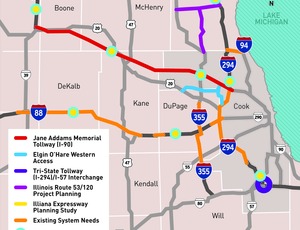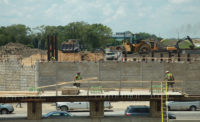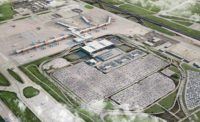

In a video shot by the Illinois Road and Transportation Builders Association, a construction worker named Robert Hall gives a testimonial for IRTBA: "It gives us a lot of work, especially when our economy was bad," the Geneva Construction Co. employee says. "IRTBA allowed us to go get more work … gave us an opportunity to keep on rolling when the housing economy was bad."
That testimony, according to IRTBA President and CEO Mike Sturino, could just as well have been about the Illinois Tollway, a $12-billion, 15-year capital program launched in 2011. Dubbed "Move Illinois," the program is the largest in the tollway's history—and it is a welcome antidote to the budget-strapped, limited construction programs of state and local transportation agencies.
"Without the program, you'd see significant contraction in the industry, " says Sturino, noting the dire financing situation of state transportation agencies due to a dwindling federal trust fund.
An initial $5.8-billion program (ENR 6/11/07 p. 12), launched in 2008, converted the mainline toll booths into open-road tolling, reconstructed much of the system's 286 miles and extended Interstate 355. The success of that program helped increase public acceptance of the 2012 toll hike that enabled Move Illinois. "Because we had performed pretty well on the past program, we could introduce this program during a time when nobody else had anything going," says Paul Kovacs, the tollway's chief engineer.
Eighteen months of outreach also helped broaden public support. "First, we worked with our board to talk about the challenges," says Kristi Lafleur, executive director. "People support what they have a hand in creating. We put together the right presentations, went out to the public and solicited their feedback about what projects were important to them."
Local media even came out in support of the first toll increase since 1983, says James Blanusha, executive vice president at Alfred Benesch & Co. Benesch is teamed with V3 Companies of Illinois on design of seven miles of I-90 and 25 miles of corridor management. In some cases, tolls jumped by about 87%. "None of this would ever have been possible without the exceptionally well-designed and -executed public information campaign," he says.
Ramping Up
This year will feature some $1.4 billion in engineering and construction. Levels of work are expected to remain fairly constant through the rest of the decade. "The tollway has worked hard with IRTBA and the industry on the pacing, cash flow, bidding schedules, contract sizes and logistics to make sure there are no peaks and valleys," says Blanusha.
Move Illinois' major components are expanding 62 miles of the I-90 east-west corridor, known as the Jane Addams Memorial Tollway; building an all- electronic interchange linking the Tri-State Tollway (I-294) to I-57; and the Elgin O'Hare Western Access (EOWA) project, a $3.4-billion project federally labeled as having regional and national significance. It will entail 17 miles of new road and 15 miles of new or improved interchanges, providing a new western link to O'Hare airport.
"This project has been 25 years under consideration," says Chris Arman, program director with HNTB Corp., the tollway's program manager. "It will revolutionize traffic in the western suburbs." Just as the I-90 tollway spurred economic development and eased freight movement to the east of O'Hare, EOWA is expected to do the same with the eastern side.




